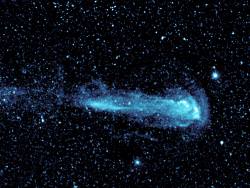If you take a quick look at the photograph with this story you’d think you’re looking at a comet. I’ve actually got it cut down the image a little to fit the website. To really see the full-sized version, check out this link. Well, that’s not a comet, it’s actually the star Mira, moving so fast through interstellar space that it’s leaving a tail behind.
Mira is an older, red giant star shedding massive amounts of material into space. As the star moves quickly through interstellar space, the particles slow down, and remain as a long tail stretching behind. In fact, this tail is 13 light-years long, or 20,000 times the average distance of Pluto from the Sun.
The image was captured by NASA’s Galaxy Evolution Explorer satellite, and the researchers announced their findings during a NASA press conference today. Their research will be published in the latest issue of the journal Nature.
Billions of years ago, Mira was probably quite similar to our own Sun. As it ran out of hydrogen fuel, the star swelled up, becoming an enormous red giant. It’s known as a variable red giant, and pulsates on a regular basis, puffing up its outer layers and brightening enough to be visible with the unaided eye. Eventually the star will run out of material, and settle down as a white dwarf star.
Since it’s traveling at 130 km/s (80 miles/s), all this material cast off by Mira builds up on the leading side; it creates a bow shock in the front, where sloughed off gas is compressed as it encounters the interstellar winds. The compression causes the gas to heat up and blaze in the ultraviolet spectrum. This material then swirls around behind the star, creating a turbulent, tail-like wake. Since the tail is only visible in the ultraviolet spectrum, it took NASA’s Galaxy Evolution Explorer -which mainly observes in ultraviolet – to find it.
Original Source: Nasa News

